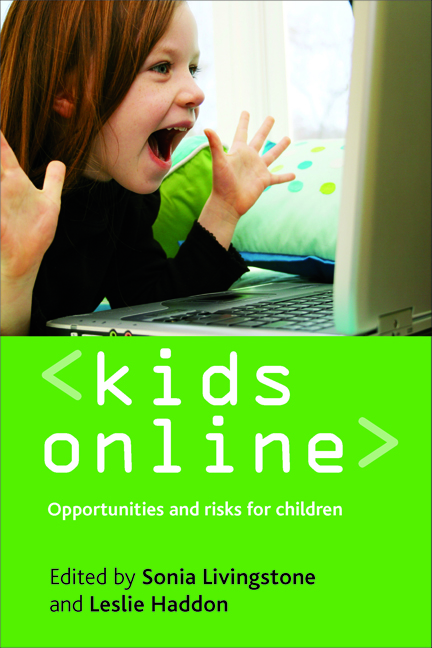Book contents
- Frontmatter
- Contents
- Notes on contributors
- Acknowledgements
- one Introduction
- Section I Researching European children online
- Section II Going online: new opportunities?
- Section III Going online: new risks?
- Section IV Policy implications
- Appendix A List of country codes
- Appendix B Children and parents online, by country
- Appendix C The EU Kids Online network
nine - Digital divides
Published online by Cambridge University Press: 15 July 2022
- Frontmatter
- Contents
- Notes on contributors
- Acknowledgements
- one Introduction
- Section I Researching European children online
- Section II Going online: new opportunities?
- Section III Going online: new risks?
- Section IV Policy implications
- Appendix A List of country codes
- Appendix B Children and parents online, by country
- Appendix C The EU Kids Online network
Summary
Digital divides: beyond access and usage
Since the mid-1990s there has been an increasing interest in the nature and extent of digital divides, and in academic circles the term itself has gradually given way to that of ‘digital inclusion’. In the mid-1990s the ‘digital divide’ has been seen in terms of a dichotomy between the ‘information haves’ and the ‘information have-nots’ (Wresch, 1996), or, in economic terms, the ‘information poor’ and the ‘information rich’ (Webster, 1995). One of the first theorisations of digital divides was based on diffusion theory (Rogers, 1995). It argued that the acquisition of and access to computers and internet equipment is a fundamental criterion for overcoming gaps and inequalities. This understanding of digital divides has been criticised for presenting a limited conceptualisation of the phenomenon, as access to information and communication technologies (ICTs) cannot be considered sufficient for overcoming exclusion from new digital opportunities (Selwyn, 2003, 2004a, 2004b; Warschauser, 2003; Bradbrook and Fisher, 2004). Carpentier (2003) analyses the discourses of academics and politicians concerning digital divides, concluding that three main lines of criticism apply: (1) a limited focus on access instead of kinds of use; (2) an over-simplified dichotomy between ‘haves’ and ‘have-nots’; and (3) a lack of clarity due to the application of the ‘digital divide’ concept to a wide variety of activities.
After 2000, scholars such as Norris (2001) presented a more complex picture of digital divides, discarding the dichotomy between haves and have-nots and at the same time taking into account the quality and efficiency of the use of digital technologies. The literature increasingly allowed more elaborated positions, suggesting a ‘thicker description of the various shades of information and telecommunications inequalities’ (Wilhelm, 2000: 69-70). Social, cultural and educational parameters influence the capability of the individual to make effective use of digital technologies through requisite skills, knowledge and support (van Dijk, 2006). Material resources and economic capacity, socialisation into the dominant culture, technical skills and awareness of the prevalent techno-culture, as well as social networks, are all forces shaping digital divides (Selwyn, 2004a). Policy strategies and regulatory practices also significantly influence the nature of digital divides in specific national and regional contexts (Tsatsou, 2008).
- Type
- Chapter
- Information
- Kids OnlineOpportunities and Risks for Children, pp. 107 - 120Publisher: Bristol University PressPrint publication year: 2009



